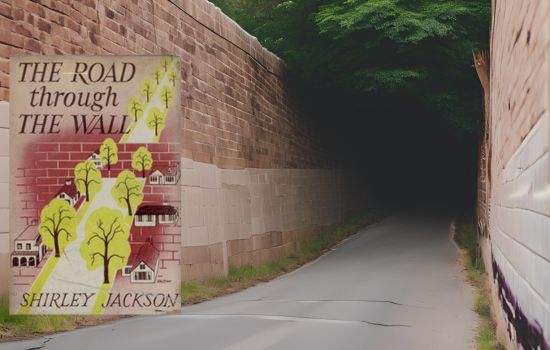
The Road Through the Wall: A Captivating Journey 1948
“The Road Through the Wall” is a striking exploration of the dark undercurrents within a seemingly idyllic suburban community. Shirley Jackson, renowned for her ability to uncover the sinister aspects of everyday life, crafts a narrative that is both a reflection and a critique of mid-20th-century American society. This summary will delve into the novel’s intricate plot, its complex characters, and the profound themes that make it a timeless piece of literature.
Plot Summary of The Road Through the Wall
Setting: Pepper Street
The Road Through the Wall is set in a seemingly perfect suburban neighborhood, Pepper Street, during the post-World War II era. This setting serves as a microcosm of American society, with its well-manicured lawns, neat houses, and the appearance of tranquility and order.

Introduction to the Patton Family
At the center of the story is the Patton family, composed of Mrs. Patton, Mr. Patton, and their children, Marilyn and David. The Pattons epitomize the conventional suburban family, striving to maintain an image of perfection and normalcy.
The Neighbors: The Wilsons, The Martins, and Others
The Wilson and Martin families are among the Pattons’ neighbors, each with their own secrets and personal dramas. Mrs. Wilson, a social climber, and her husband, Mr. Wilson, are determined to keep up appearances, while the Martins struggle with their own domestic issues.
The Arrival of Harriet Merriam
Harriet Merriam, a newcomer to the neighborhood, disrupts the delicate balance of Pepper Street. Her presence introduces new dynamics and exacerbates existing tensions among the residents.
The Growing Tensions
As the story progresses, the facade of suburban bliss begins to crack. The residents’ prejudices and insecurities come to the forefront, leading to conflicts and divisions within the community.
The Climax: The Tragic Incident
The Road Through the Wall reaches its climax with a tragic incident that shocks the community and reveals the true nature of its residents. This event serves as a catalyst for the unraveling of the social fabric of Pepper Street.
The Aftermath and Resolution
In the aftermath of the tragedy, the characters are forced to confront their own flaws and the reality of their lives. The resolution is bittersweet, highlighting the enduring impact of the incident on the community.
Character Analysis

The Patton Family
Mrs. Patton
Mrs. Patton is a quintessential suburban housewife, obsessed with maintaining her family’s image. Her interactions with the neighbors and her rigid adherence to social norms reveal her deep-seated insecurities.
Mr. Patton
Mr. Patton, though less concerned with social status than his wife, is complicit in upholding the facade of normalcy. His passive demeanor masks a sense of dissatisfaction with his life.
Children: Marilyn and David
Marilyn and David, the Patton children, navigate the pressures of living up to their parents’ expectations. Their experiences reflect the generational tensions and the impact of societal norms on the youth.
The Wilson Family
Mrs. Wilson
Mrs. Wilson is a social climber who prioritizes appearances over genuine relationships. Her interactions with other characters are often manipulative and self-serving.
Mr. Wilson
Mr. Wilson, though more grounded than his wife, struggles with his own ambitions and the expectations placed upon him.
Children: Harriet and Virginia
Harriet and Virginia, the Wilson children, are caught in the crossfire of their parents’ aspirations and the realities of their own desires and personalities.
The Martins
Mrs. Martin
Mrs. Martin is a more sympathetic character, often feeling trapped by the societal expectations imposed upon her.
Mr. Martin
Mr. Martin’s indifference and detachment contribute to the family’s internal conflicts.
Children: Michael and Daphne
Michael and Daphne, the Martin children, each cope with their family’s dysfunction in different ways, highlighting the impact of the domestic environment on individual development.
Other Significant Characters
Aubrey Wheeler
Aubrey Wheeler is a key figure whose actions and attitudes exemplify the themes of hypocrisy and moral ambiguity in the Road Through the Wall.
Miss Fielding
Miss Fielding, an older, unmarried woman, provides a contrasting perspective on the societal norms and pressures faced by the other characters.
Themes and Motifs

Suburban Hypocrisy
Jackson’s portrayal of Pepper Street underscores the hypocrisy prevalent in suburban communities, where appearances often mask deeper issues.
Social Conformity
The Road Through the Wall explores the pressures to conform to societal expectations and the consequences of deviating from these norms.
Racial and Class Prejudice
Jackson addresses issues of race and class, highlighting the prejudices that permeate even seemingly progressive communities.
The Illusion of Perfection
The characters’ relentless pursuit of perfection is revealed to be an illusion, with devastating consequences for their personal lives and relationships.
Isolation and Alienation
Despite their proximity, the residents of Pepper Street experience profound isolation and alienation, unable to form genuine connections.
Shirley Jackson’s Writing Style
Narrative Techniques
Jackson employs a third-person omniscient narrative, allowing readers to gain insight into the thoughts and motivations of multiple characters.
Use of Irony and Satire
The Road Through the Wall is rich with irony and satire, critiquing the superficiality and moral failings of suburban life.
Psychological Insight
Jackson’s deep psychological insight into her characters adds depth to the narrative, making their experiences and motivations highly relatable.
Symbolism
Symbolism is used effectively throughout the Road Through the Wall to underscore its themes, from the physical barriers between the houses to the Road Through the Wall that the characters build around themselves.
Critical Reception
Initial Reviews in 1948
Upon its release, “The Road Through the Wall” received mixed reviews, with some critics praising Jackson’s sharp social commentary and others criticizing its bleak portrayal of suburban life.
Modern Critical Analysis
Today, the novel is regarded as an important work in Jackson’s oeuvre, appreciated for its incisive critique of post-war American society and its influence on subsequent literary explorations of suburban life. Read another horror book The Lair of the White Worm: A Classic Horror Tale.
Jackson’s Influence on Subsequent Literature
Shirley Jackson’s debut novel paved the way for her later works, such as “The Haunting of Hill House” and “We Have Always Lived in the Castle,” solidifying her legacy as a master of psychological and social horror.
Conclusion
“The Road Through the Wall” remains a powerful exploration of the dark undercurrents within a seemingly perfect community. Through its complex characters and profound themes, the novel offers a timeless critique of societal norms and the human condition. Shirley Jackson’s debut work continues to resonate with readers, highlighting the enduring relevance of her insights into the complexities of suburban life.